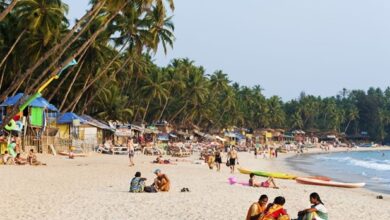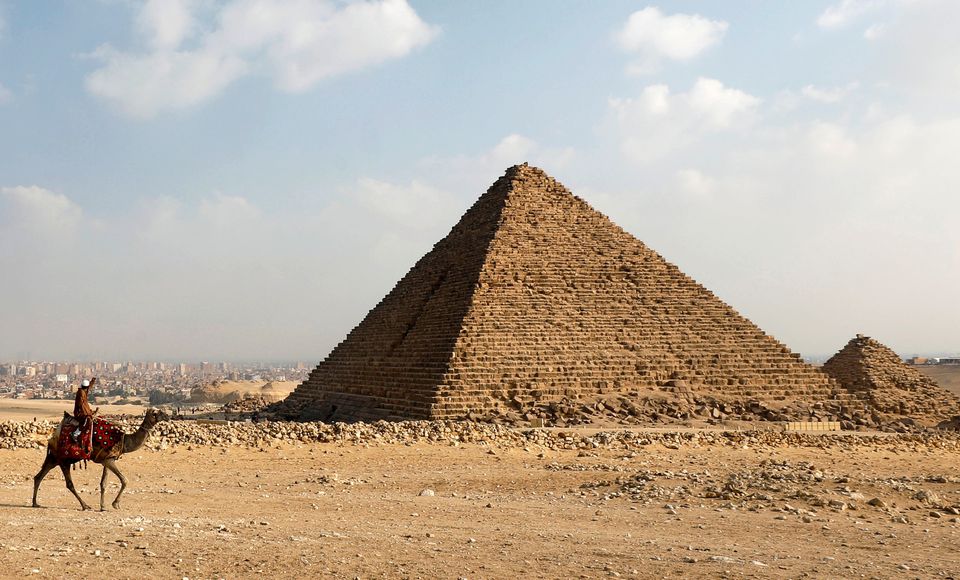After regaining the Sinai Peninsula in 1981 as part of its peace treaty with Israel, the Egyptian government began to develop its southern half for tourism. Its development plan for the region, however, continues to raise questions about the sustainability of Dahab as a laid-back resort.
In Sharm el-Sheikh, planners eye tourists looking for all-inclusive beach resorts and a vibrant nightlife. North of Sharm lies Dahab, a quieter alternative where visitors can enjoy nature during the day, then relax for a social yet relatively quiet evening.
But with continued development in Dahab, currently occurring without state enforcement of regulations to protect the Red Sea, Dahab enthusiasts are concerned that it will lose its low-key, eco-friendly character and simply become South Sinai’s next Sharm el-Sheikh.
Sarah Mounira, 45, a business advisor based in Paris, travels to Dahab frequently. She remembers the first time she visited 11 years ago. “I was planning to stay two weeks, and I left three months later,” she says.
Mounira returns to Dahab “not just because it is affordable, the beauty of the nature, the magic of the desert, or the diving, but also – and more so – because of the people.”
She speaks fondly of those living and working in Dahab, as well as of travelers she met there. “It is like when you go back to your hometown to visit friends and family,” she says.
But with a planned increase in hotels – many catering to a different type of tourist than those Mounira generally meets in Dahab – the town's culture is poised for radical change.
“They are making Dahab like Sharm,” says 32-year-old Dahab dive instructor Ahmed Marof. Marof called Sharm el-Sheikh “a factory” for mass tourism.
A 2004 working paper on South Sinai Tourism produced by the Egyptian Environmental Affairs Agency recommends that Egypt promote resort-style tourism.
“Individual and small-group tourists are a small segment of the market,” it lamented.
But it is individual and small-group tourists that abound in Dahab. On its website, the Chamber of Diving and Water Sports (CDWS) refers to Dahab as “the famous ‘hippy’ town of the Red Sea Riviera,” as the town generally attracts people uninterested in resorts.
Anticipating the environmental challenges of South Sinai development, Egypt’s Environment Ministry and South Sinai Governorate produced the South Sinai Environmental Action Plan in 2004. As Environment Minister Maged George explains in the plan’s foreword, “With such growth inevitably comes development pressure on the environment.”
The plan anticipates that by 2017, Dahab will have 227 hotels with 10,232 rooms, increases of 134 percent and 248 percent respectively, from the town's 2003 numbers.
Accompanying this expansion will be an increase in Dahab’s permanent population, about a third of which is expected to work in the tourism industry. The plan’s “conservative estimate” anticipates Dahab’s population to increase to 31,744, over four times the 2003 population of 7628.
Hamdy Anan, a 33-year-old dive instructor, moved to Dahab from Mahalla 16 years ago, not just for the diving, but also because of Dahab’s small-town feel. Anan says that even today, tourists can leave their belongings on the beach knowing that no one will take them. Anan also says that if any of his three Dahab-born sons wandered from sight, someone from the Dahab community would ensure his safety.
Currently, Anan’s major concern is the fact that restaurants and hotels are beginning to monopolize beach spaces and block entrances to Dahab’s limited dive sites. He believes that this is only the beginning of Dahab’s transformation into an impersonal, money-driven tourist center.
“This is a step toward damaging the city completely,” he says.
He may be right. Sharm el-Sheikh once had unimpeded access to all of its shore. Today, Sharm’s entire waterfront is dominated by private entities, largely resort-style hotels catering to vacationing Europeans.
Fellow dive instructor Marof has also been in Dahab for 16 years, after moving there from Cairo. Like Anan, Marof says that development in Dahab is occurring without adherence to safety and environmental regulations. Cement used for construction sometimes ends up in the sea, he says, and restaurants along the shore are being extended over the water.
Marof explains the ease with which one can open a dive center in Dahab. He is concerned that some of the dive centers may not be as environmentally-conscious as others.
Anan adds that hotel sewage sometimes overflow into the Red Sea, damaging coral reefs and their fragile ecosystems.
The concerns expressed by Anan and Marof are mostly new. The men say that development in Dahab began to proceed unchecked particularly after the 25 January revolution.
Before the revolution, the Tourism Ministry funded the CDWS to enforce environmental and safety regulations to protect Egypt’s sea-related assets. After the uprising, though, the ministry stopped funding the CDWS to carry out such functions, thereby creating a regulatory void at Dahab and similar sites.
Zeyad al-Bassell, the managing director of the CDWS, says that now his agency only serves as an administrative body, licensing diving, water sports and safari operations in Egypt. As far as assigning responsibility for the CDWS’s prior role, “all inspection and rules and regulations enforcement are the responsibility of the [Tourism Ministry],” he says.
Bassell adds, “As for the environmental challenges in Dahab, as well as other sites and cities, the CDWS has repeatedly addressed and warned [of them] to the responsible entities and state departments: the Tourism Ministry, the Ministry of the Environment, as well as local governors."
Marof says that while enforcement was never perfect, it was better before 25 January. “We had authorities. Now we don’t have anyone.”
Marof and Anan go on to say that none of the government bodies listed by Bassell have stepped in to fill Dahab’s regulatory void.
When asked about local recourse for punishing violators, Anan says, the “city council doesn’t want to do anything about it.”
Concerned that environmental damage will dissuade tourists from coming to Dahab, Anan is dismayed by the lack of attention shown by Dahab’s city council. “This city is based on tourists and diving. If there are no tourists and diving, the city is not useful,” he says. Officials at Dahab’s city council, as well as officials at the Tourism Ministry, declined to speak with Al-Masry Al-Youm about Dahab’s development.
However, Egypt’s 2004 environmental report warns that the increase in hotel rooms may reduce the price of travel to the extent that tourists who were only interested in an inexpensive, fun vacation – and not in observing and preserving nature – would now choose Dahab.
Marof says that he has already begun to observe a new type of tourist in Dahab. Recent tourists throw trash in the sea from Dahab’s seaside restaurants, and others damage coral reefs by touching or even sitting on them.
The 2004 environmental report also notes that based on a survey of South Sinai tourists, those in Dahab were more interested in diving and water sports than their counterparts in the rest of South Sinai. Thus, blocking access to dive sites and allowing environmental damage to Dahab’s coastline promises to further change the profile of Dahab’s visitors, as those looking to enjoy and explore the Red Sea may elect to forgo an altered Dahab.
But with promises of increased employment and income from resort-style vacations, the planned development in Dahab is moving forward. And with the current unenforcement of safety regulations to protect the Red Sea, Dahab's most valuable natural asset, the town may simply go the way of Sharm el-Sheikh and mass tourism.
In the wake of such changes, it remains uncertain that the Egyptian government will adopt measures to preserve Dahab’s unique character.
Marof is frustrated by the government's seeming indifference to Dahab's community. “Who are we? Some divers in Dahab? Who'll listen to us?” he wonders.




